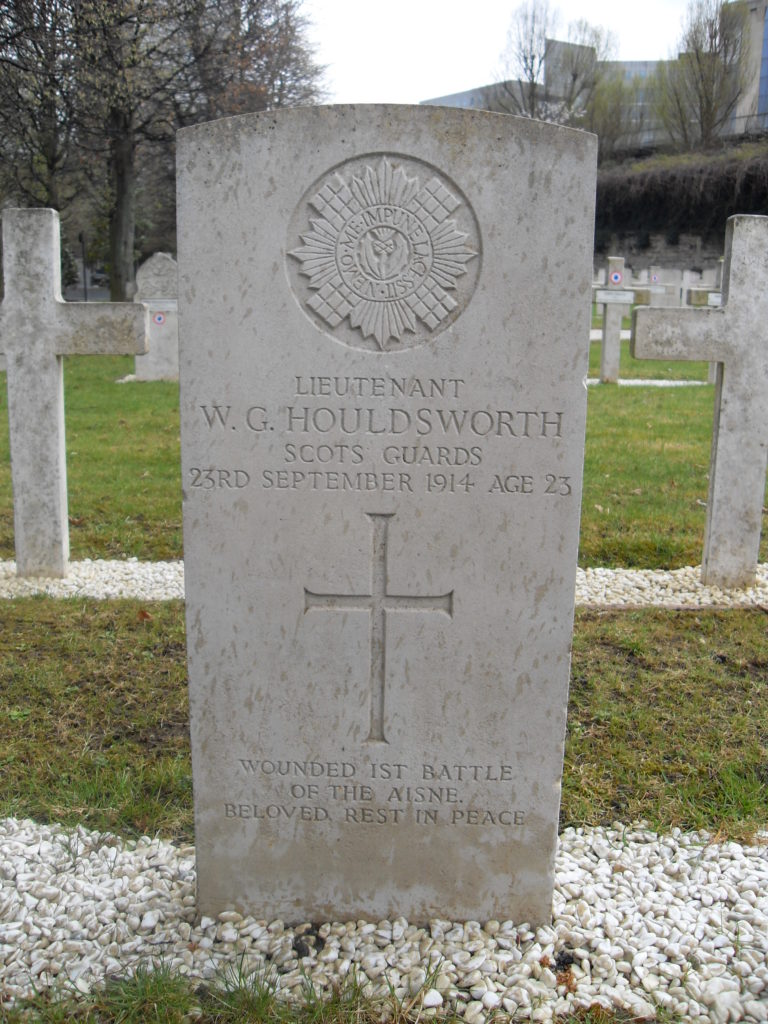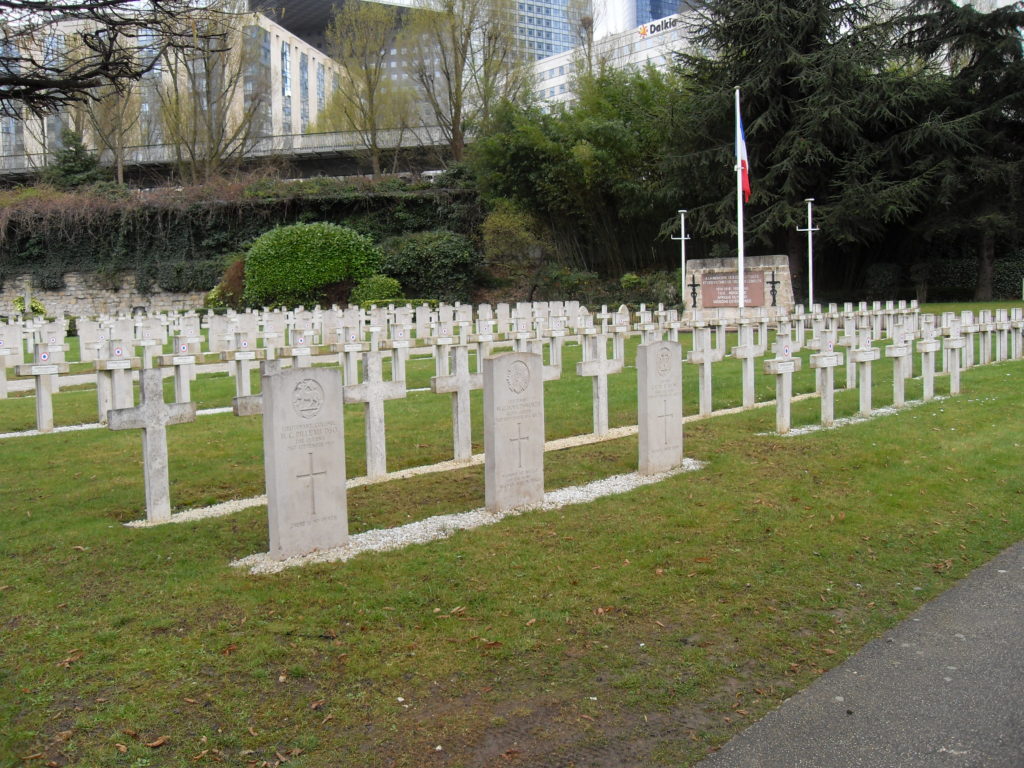Fact file:
Matriculated: 1910
Born : 17 May 1891
Died: 23 September 1914
Regiment: Scots Guards
Grave/Memorial: Neuilly-sur-Seine New Communal Cemetery: 4.23.2
Family Background
b. 17 May 1891 as the only surviving son (three sisters) of Revd William Thomas Houldsworth, MA (1846–1935) and Eulalie Houldsworth (née Venables) (1852–1923) (m. 1873), 1, Mansfield St, London W1; 44, Lennox Gardens, Kensington, London SW1; Cranston, North Berwick; and Glentruim House, Newtonmore, Inverness-shire.
Parents
Houldsworth’s father was the great-nephew of Thomas Houldsworth, MP (1771–1852), Lord of the Manor of Epperston, and the grandson of Henry Houldsworth (1774–1853) who, in the 1790s, founded Thomas Houldsworth and Co., Manchester’s third largest firm of cotton-spinners by 1815. He studied at Trinity College, Cambridge, and was Curate of St James’s, Bury St Edmunds from 1871–1872, and then Curate of St James’s, Tunbridge Wells in 1875. After being ordained priest in 1885, he was briefly Curate of St Peter’s, Eaton Square (1885–86), after which he became the Vicar of St Andrew’s, Wells St, Marylebone, London, from 1886 to 1904. A fashionable clergyman, he was at some time Chairman and Treasurer of the Clergy Widows Fund, and had a particular concern for the religious education of children from the wealthier classes.
Houldsworth’s mother was the daughter of a merchant.

William Gilbert Houldsworth, BA
(Photo found as part of an unidentified newspaper cutting in “Gunner’s Scrapbook”, MCA, Acquisition No. 14/175)
Siblings and their families
Brother of:
(1) Lillie Caroline (1877–1950) (Gibbs after her marriage [1905] to Gerald Henry Beresford Gibbs [1879–1939], the 3rd Baron Aldenham [from 1936]);
(2) Marian Edith (1884–1976) (later Wyld after her marriage [1907] to the cricketer Hugh James Wyld [1880–1961]);
(3) Dorothy Elizabeth (1894–1951) (Gibbs after her marriage [1915] to Captain [later Lieutenant-Colonel] Ralph Crawley-Boevey Gibbs [1891–1957], Magdalen 1910–12), 2 sons, 3 daughters.
So through the marriages of two of his sisters, Houldsworth was distantly related to E.L. Gibbs. This means that if Houldsworth had lived, he would also have become even more distantly related by marriage to Walter Durant Gibbs (1888–1969), who became the 4th Baron Aldenham on Gerald Henry Beresford’s death in 1939 and had married the widow of A.H. Villiers in 1919.
Education
From c.1898 to 1904, Houldsworth attended Wellington House Preparatory School, Westgate-on-Sea, Thanet, Kent (1886–1970), where he was tutored by its headmaster, the Revd Herbert Bull (1854–1928), a graduate of Trinity College, Cambridge (cf. H.R. Inigo-Jones, A. Graham Menzies); Bull had co-founded this school in 1886, two years after he was ordained deacon, and two years before he was ordained priest and instituted as the Curate of St Saviour’s Church, Westgate-on-Sea. Houldsworth then attended Eton College from 1904 to 1909. He matriculated at Magdalen as a Commoner on 18 October 1910, having taken Responsions in Michaelmas Term 1909. He took the First Public Examination in the Hilary and Trinity Terms of 1911 and then read for a Pass Degree (Groups A1 [Greek and/or Latin Literature/Philosophy], E1 [The Elements of Military History and Strategy]), and acquired an additional Certificate in Tacitus. He was awarded his Degree in 1913 and took his BA on 12 March 1914 alongside C.R. Priest. A keen sportsman, a good horseman and a powerful golfer, he was a member of the Bachelor’s and Conservative Clubs, London, and of the New and Tantallon Clubs, North Berwick. When making his will, he gave his address as 44, Lennox Gardens, Middlesex.
Military and war service
Houldsworth joined the Oxford University Officers’ Training Corps (OUOTC) during his first term at Magdalen and on 1 July 1912 was commissioned as Second Lieutenant on probation on the unattached list of candidates in the OUOTC. On graduating from Oxford in 1913, he joined the Scots Guards, and from 6 May to 15 July 1914 he was stationed at Aldershot, serving in the Regiment’s 1st Battalion alongside Inigo-Jones and Graham Menzies. On 14 August 1914 he was confirmed in the rank of Second Lieutenant (with eighteen months seniority as a University Candidate) and in September 1914, not long before his death, he was promoted Lieutenant because of that seniority.
The Battalion left Aldershot, Hampshire, for Southampton on 13 August 1914 and reached Le Havre on 15 August. It entrained later on the same day, and travelling north-westwards via Rouen, Amiens, Arras and Cambrai, arrived at le-Nouvion-en-Thiérache on 16 August. From here it marched for five days, first north-east to Cartignies (21 August) and thence to the Belgian border, which it crossed on 22 August, arriving at Grand Reng on the following day. Here, as part of the 1st Guards Brigade, 1st Division, it was on the extreme right of I Corps, next to the French 5th Army. The German attack southwards from Belgium into France towards Paris began on 23 August, and on the following day the Battalion began its long withdrawal south-south-westwards for ten days, sometimes marching for 30 miles in a day in very hot and trying conditions, until it reached Chambry on 2 September, where, as part of the 1st Division’s rear-guard, it covered the 1st Division’s crossing of the Grand Morin river at Coulommiers. On 3 September the Battalion crossed the Marne at Germigny; on 4 September it reached Coulommiers; and on 5 September it halted at the village of Nesles, just north of Rozay-en-Brie, where its retreat from Mons came to an end. From 6 to 9 September 1914, the Battalion took part in the general advance north-eastwards: it crossed the River Marne at Nogent l’Artaud on 9 September, and from there it went to Bazoches-sur-Vesles (12 September) before crossing the River Aisne, the Aisne Canal and the Aisne et Oise Canal on 13 September, the beginning of the Battle of the Aisne.
On the same day Houldsworth’s father wrote a letter to President Warren in which he said: “[Ralph Gibbs (see above)] was one of my boy’s closest friends. Their devotion to each other is strongly cemented & they are intensely happy. Oxford must present a strange Contrast to what it has been & a very depressing contrast – I suppose you watch all these young lives with the probability of their going to the front as soon as they are allowed – & keen to get there. Well, it will make men of them earlier than in the past.” But on that very day, Houldsworth was severely wounded in the head by long-range artillery fire near Paissy, a tiny village just south of the eastern end of the Chemin des Dames (see G.M.R. Turbutt), one of the Battalion’s 17 casualties killed, wounded and missing on that day. He died of wounds received in action on 23 September 1914, aged 23, in the American Hospital, Neuilly-sur-Seine, Paris. Buried: Neuilly-sur-Seine New Communal Cemetery, Rue de Vimy, Neuilly-sur-Seine, a suburb due west of the Porte Maillot, Paris, that is just behind La Défense [follow signs to Puteaux]); Grave 4.23.2; inscription: “Wounded 1st Battle of the Aisne. Beloved Rest in Peace”. He is commemorated on monuments in St Andrew’s Church, Wells St, London W1 and St Peter’s Church, Eaton Square, Belgravia, London SW1.

Neuilly-sur-Seine New Communal Cemetery, Rue de Vimy, Neuilly-sur-Seine [not Courbevoie as the CWGC says], a suburb due west of the Porte Maillot, Paris; Grave 4.23.2.
The small porch of St Baldred’s Church, Dirleton Ave., North Berwick, East Lothian was added in 1917 and contains a marble plaque bearing the inscription “to the Glory of God and in Loving Memory of Two Friends”. One of these was Houldsworth and the other was Second Lieutenant Archibald Seymour Ross (1889–1915) (killed in action on 9 May 1915, aged 24, during the Action at Richebourg l’Avoué, while serving as a Second Lieutenant in the 1st [Regular] Battalion, the Cameron Highlanders). Inside the porch and affixed to the two opposite walls two wooden crosses are nailed to the inner wall. Judging from their state of repair, both were used on the two men’s original graves: Houldsworth’s well away from the front and Ross’s much nearer the front. No known grave.
Houldsworth died intestate but his estate was valued at £791 14s 1d.

Probably the original wooden cross that was used on Houldsworth’s original grave in or near the Paris suburb where he died, as it shows no sign of war damage.

Neuilly-sur-Seine New Communal Cemetery, Rue de Vimy, Neuilly-sur-Seine [not Courbevoie as the CWGC says], a suburb due west of the Porte Maillot, Paris. The Cemetery is mainly for civilians, but contains a large number of French graves from the opening months of the war and about 32 British and Commonwealth graves.
Houldsworth’s grave is the middle one of the three graves that form the left of the front row.
Bibliography
For the books and archives referred to here in short form, refer to the Slow Dusk Bibliography and Archival Sources.
Printed sources:
[Anon.], ‘A public meeting …’ [untitled], The Times, no. 38,247 (4 February 1907), p. 7.
[Anon.], ‘Clergy Widows Fund’, The Times, no. 39,534 (16 March 1911), p. 4.
[Thomas Herbert Warren], ‘Oxford’s Sacrifice’, The Oxford Magazine, 33, no. 1 (16 October 1914), p. 11.
Clutterbuck, i (1915), p. 196.
‘Archibald Seymour Ross’, De Ruvigny’s Roll of Honour, 1914–1919, vol. 1 (1916), p. 313.
Petre, Ewart and Lowther (1925), pp. 4 and 13–21.
William Houldsworth MacLeod and Henry Hamilton Houldsworth, The Beginnings of the Houldsworths of Coltness (Glasgow: Jackson, Son & Co., 1937).
Leinster-Mackay (1984), pp. 4, 175, 193, 330.
Archival sources:
MCA: PR32/C/3/700-710 (President Warren’s War-Time Correspondence, Letters relating to W.G. Houldsworth [1914]).
MCA: Ms. 876 (III), vol. 2.
OUA: UR 2/1/72.
WO95/1263.
WO339/10349.


